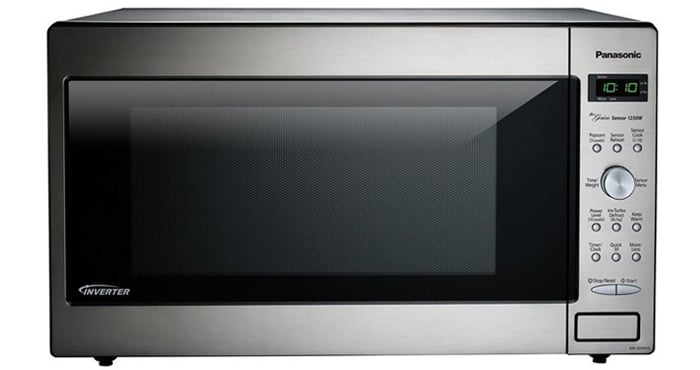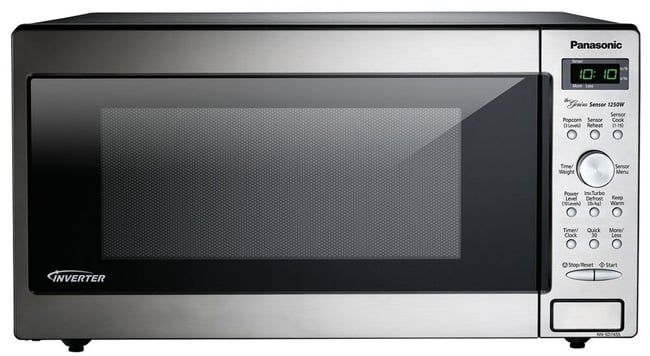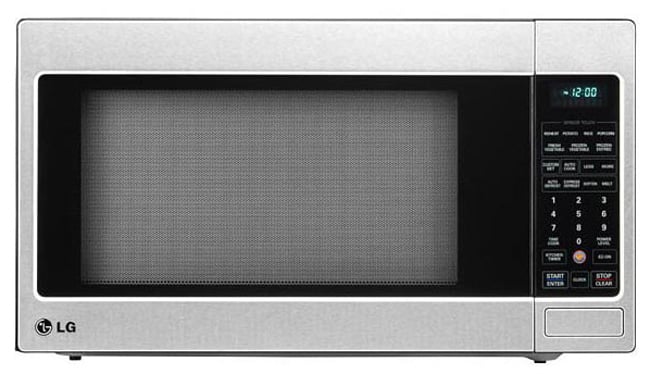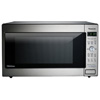We may earn commissions when you buy from links on our site. Why you can trust us.
The Best Countertop Microwave Oven
UPDATED 3/1/2017: Our previous best microwave pick, the Panasonic NN-SE982S, has been discontinued by Panasonic. Instead, we’re recommending its sister model, the Panasonic NN-SD945S. The two models are identical in every way except that the time control on the SD945S is managed by a knob, rather than an electrostatic dial. Since many users prefer the knob, this was an easy choice. We’ve updated the article to reflect this change, as well as provided many updates on other models and reviews.
 In most homes, the microwave only serves a few basic tasks: boiling water, popping popcorn and heating the occasional frozen dinner. And there's a good reason for this; microwaves offer little control over how heat is delivered. Try to get too fancy with the cooking and you'll likely end up with over-cooked edges and curdled sauces. But our pick for the best microwave, the Panasonic NN-SD945S, offers a unique "inverter" technology that offers precise control over power delivery and greatly increases the microwave's utility.
In most homes, the microwave only serves a few basic tasks: boiling water, popping popcorn and heating the occasional frozen dinner. And there's a good reason for this; microwaves offer little control over how heat is delivered. Try to get too fancy with the cooking and you'll likely end up with over-cooked edges and curdled sauces. But our pick for the best microwave, the Panasonic NN-SD945S, offers a unique "inverter" technology that offers precise control over power delivery and greatly increases the microwave's utility.

Why we picked the Panasonic NN-SD945S
When looking for the best countertop microwave, there were two basic considerations: we wanted plenty of room for large dishes and plenty of power. That meant narrowing the choices to those with a capacity over 2.0 cubic feet (usable capacity will be less) and at least 1200 Watts of power. That left more than a dozen models from GE, Kenmore, LG, Panasonic, Sharp and others. All of which had similar convenience features, such as sensor cooking/reheating and buttons for the most commonly cooked items, like popcorn.
However, there was one other feature that needed to be on my must-have list— inverter technology.
"What is inverter technology and why do you need it?", you ask. Good question.
The inverter feature transforms your microwave from an oversized reheating device into a functional cooking tool. Typical microwaves use a magnetron—the element that cooks the food in most microwaves—that can only operate at full power. When you set it to cook at “50% power”, what the microwave oven is really doing is cycling the power on and off, delivering 100% power followed by periods of no power.
Microwaves that use an inverter board are able to control the amount of power being delivered to the magnetron. So when you set it to 50%, it actually delivers a steady stream of 50% power. The result is more evenly cooked food and the ability to keep foods warm until mealtime. Plus, because you can set it to run at a very controlled, low power, you can use inverter microwaves to melt chocolate and butter, cook hollandaise sauce and perform other "real" cooking tasks that would normally be done on your stovetop.
Panasonic, which owns the patent for the inverter technology, used to license it to other manufacturers, such as Amana, GE, and Whirlpool. It appears the licensing has stopped. With the exception of the GE JES2251SJ, only Panasonic currently has countertop inverter microwaves on the market.
Panasonic has multiple 2.2 cubic foot inverter models, all nearly identical except for slightly different control pads and exterior design. I confirmed with Panasonic that the cooking technology behind their 2.2 cubic foot models is the same, so choosing which one to go with is more a matter of personal taste than performance. The NN-SD945S has a sleek, modern stainless steel body and minimalist keypad that would look great in any kitchen.
Microwave test results
We tested the inverter feature on a similar Panasonic model extensively back in 2009 and came away impressed. We used the microwave to make hollandaise sauce, melt chocolate and even pulled pork; all things that would be near-impossible in a standard microwave. We found more benefits from the inverter this time around. For instance, rice—one of my microwave recipe staples—overflows every time in my standard microwave because, even when set to "low", the short bursts of full power cause the water to boil too rapidly. The Panasonic NN-SD945S inverter is able to deliver true "low/med" power and rice cooks perfectly without a spill.
We’ve attempted to do many of these cooking tasks in non-inverter microwaves and the results are unsatisfactory. The outside of the food gets too hot from the initial blast, causing burned chocolate and curdled eggs in my hollandaise.
The NN-SD945S, like most large microwaves, also has a cooking sensor that measures the amount of steam being released to determine doneness of whatever you're cooking or reheating. No more guessing at cooking times or power levels. Just throw your food on the tray, hit sensor cook, tell the microwave what you're making (you can skip this step when reheating) and you're good to go. The microwave will modulate the power and time based on the sensor readings.
In our testing, the sensor did an excellent job reheating leftovers, cooking frozen entrees and pretty much whatever else I threw at it. Our aforementioned rice came out perfectly, whether we were cooking one cup or two. The only time we found the sensor struggling was when we were reheating small quantities of food. We presume there wasn't enough steam generating to trigger the sensor to stop.
The NN-SD945S's "Turbo Defrost" worked well...for a microwave. Meat still came out slightly dried on the outside. We find it much easier to defrost meat quickly using the warm water method—place meat in Ziploc bag, press out air and submerge in warm water. The water method works quickly without drying or cooking the outside.
The warming mode (up to 30 minutes) came in handy for a side dish of polenta when our main course was delayed and we were running out of stovetop space. And because it is warming using steady power from the inverter, we didn’t end up with overheated edges.
The controls on the SD945S were clearly labeled and easy to use. The sensor functions worked so well that we rarely needed to set a specific cook/reheat time. The dial offers more food cooking options – 18 in all including, Potatoes, Frozen Entrées, Oatmeal, White Rice, etc. – than a keypad would.
While design may not be your primary focus with a microwave, the Panasonic is very attractive with its brushed stainless steel cladding.
What other reviewers think
True microwave oven reviews (where people actually cook with them) are few and far between. And those few reviews out there tend to focus on the “typical” microwave cooking uses: popping popcorn, defrosting meat, heating leftovers. There’s nothing wrong with that – we pop popcorn in the microwave, too – but it ignores the added cooking features the inverter offers. We’re also reluctant to put too much weight into other reviews as we’ve found significant differences in opinion on the recommended models, which suggest to me that the results may have as much to do with the idiosyncrasies of the testing as the microwave, itself. That said, the Panasonic models have consistently placed near the top.
The Sweethome recently tested smaller (1.6-cubic-foot vs 2.2-cubic-foot models) and ended up with the Panasonic NN-SE785S (which uses Panasonic’s new “cyclonic wave” technology) and the GE JES1656SRSS as their top picks. Ultimately, the GE won out for outperforming the Panasonic in its ability to cook a baked potato and popcorn. Unfortunately, the testing did not include any of the trickier cooking tasks we outlined above. The GE also gets very poor reviews from owners on Amazon – raking in only 3.1 out of 5 stars, with 43% of reviews only giving it 1 or 2 stars.
CNET reviewed five models in 2013 from Amana, GE, Panasonic, Sharp and Whirlpool. They gave 4 out of 5 stars to the Panasonic NN-SD997 (a discontinued model very similar to ourrecommended NN-SD945). Interestingly, the Panasonic excelled in the baked potato test (unlike with Sweethome); suggesting that variability in testing methodology may have a lot to do with end results.
Consumer Reports (subscription required) has a roundup with dozens of models. Unfortunately, not all the testing was done at the same time, leading to potential for testing methodology idiosyncrasies, and many of the models are discontinued. They didn’t specifically rate the NN-SD945S, however other large Panasonic models received either the top rating (74 out of 100 points) or one point off the top rating. Notably, Sweethome’s top pick, the GE JES1656SRSS, came in near the bottom of the pack (58 points). The only non-discontinued microwave in CR’s top rating category is the LG LCRT2010. It gets good reviews on Amazon with 4 out of 5 stars and an excellent 4.5 out of 5 stars on Best Buy.
However (and there always seems to be a “however” with microwave reviews), Reviewed.com found the performance of the LG LCRT2010 to be sub-par, giving it only 5.9 out of 10 points for its “iffy results” in their evenness testing and defrosting results. Instead, they recommended the Panasonic NN-SN973S, granting it 9.4 out of 10 points for its “impressive ability to heat food quickly and evenly”. The NN-SN973 has been discontinued, but it is identical from a cooking perspective to our recommended Panasonic NN-SD495, and uses a keypad instead of dials for the controls.
What consumers think
We always look at consumer experiences, where possible, when we review products. Actually living with a device for six months or more gives you a very different perspective than any lab testing. And for microwaves, this is especially important given the reliability issues with so many of the models.
The Panasonic NN-SD945S received excellent reviews on Amazon with 4.5 out of 5 stars, with 90% giving it four or five stars. That’s impressive, especially for microwaves. Not that Panasonics haven’t been without their issues. Some models have had issues with the door latches. And the inverter board has been known to fail more frequently than the simpler magnetron on other brands. But in aggregate, the Panasonics have been higher reviewed than other models, including the top picks from the other reviews mentioned above.
Other choices
For those looking for a smaller oven, the Panasonic NN-SD745S offers the exact same features as the SD945S in a 1.6-cubic-foot capacity. Though at around $180 on Amazon, it's only about $10 cheaper than the larger model.

Smaller option: Panasonic NN-SD745S
The LG LCRT2010 gets top ratings from Consumer Reports and very strong reviews from consumers on both Amazon and Best Buy. It also offers TrueCookPlus, which standardizes the optimum cooking time for frozen foods – accounting for all of the variables that impact the cooking time of microwaveable foods, such as oven temperature, wattage, oven size, voltage, altitude and power settings. The problem is, many food brands don’t use TrueCookPlus codes, which greatly limits its usefulness, and Reviewed.com found that the microwave does a horrible job defrosting frozen food. Though for around $158 on Amazon, it’s a great budget choice.

Lower cost option: LG LCRT2010ST
The Panasonic NN-SD975S uses Panasonic’s newer “cyclonic wave” technology, which is supposed to deliver more even distribution of the microwaves within the oven for more even cooking. In Sweethome’s testing of a cyclonic model, they didn’t see a benefit to this technology over the standard wave distribution in the GE oven. Given that the SD975S is $80 more than our recommended SD945S, and is otherwise identical in features, we believe the SD945S offers a far better value.
The GE JES1656SRSS is Sweethome’s top pick, but got a mediocre review on Consumer Reports and terrible reviews on Amazon – we would avoid it.
Final call
If all you want to do is make popcorn, boil water and reheat soup, almost any microwave will suit your needs. But the inverter technology found in the Panasonic NN-SD945S adds significant functionality to a device that is likely taking up a fair amount of space in your kitchen. We've used Panasonic inverter microwaves to braise meats, make sauces, melt butter and keep food warm using gentle heat—not tasks you would typically entrust to a microwave.
For its combination of cooking excellence, simplicity of controls, design and excellent owner experience, the Panasonic NN-SD945S is our top pick.
Panasonic NN-SD945S
Why you should consider an extended warranty for your microwave
We don't usually recommend extended warranties for electronics. For the most part, they're not worth the money (your credit card may already double the manufacturer's warranty, giving you two years of coverage for most electronics). However, microwave ovens are an exception. Here's why:
- We've seen an unsettling number of complaints from consumers about microwave failures during the first couple years of use. These complaints go across brands. Apparently, they're not making them like they used to.
- Even if your microwave fails during the warranty period, you will be responsible for shipping it to the manufacturer for repairs (at your expense) or bringing it to an authorized service center (which are always further away than you would like). You still have the original recipt and box for shipping, right?
- Manufacturers usually warrant the magnatron for 5-10 years, but this only covers the cost for parts—you're still responsible for labor.
- The cost of shipping and repairing a microwave out of warranty can easily be more than the price of just buying a new microwave.
Our recommended microwave extended warranty provider is Squaretrade. You can purchase a Squaretrade 3-year $200-$250 protection plan on Amazon for about $26 (plan starts at date of purchase). During that period, Squaretrade will:
- Provide a free shipping label for warranty repairs either to the manufacturer or Squaretrade's service facility
- If your product cannot be repaired, they will provide a cash settlement or gift card reflecting the replacement cost of a new item of equal features and functionality up to the Coverage Amount or provide a new or refurbished product of equal features and functionality.
Alternatively, you can purchase a Geek Squad protection plan for microwaves purchased through Best Buy. A 2-year $200-$250 protection plan will cost about $30 (plan starts at date of purchase). During that period, Best Buy will:
- Let you bring your microwave into any Best Buy location to handle and manufacturer warranty or post-warranty repair.
- If your product cannot be repaired, they will either replace it with a product of like kind and quality and of comparable performance or reimburse you for replacement with a voucher or gift card equal to the product's current market value.
Whether you would find it more convenient to bring your microwave into a Best Buy or ship it from your home is a matter of personal choice. Howvever, the Best Buy warranty is more expensive and you would only be reimbursed in cash for the product's current market value, not a new replacement item.
Discussion 
Thank you for the wonderful review! My microwave just broke tonight after 7 years and it is indeed looking as if ALL microwaves are AWFUL now for durability! Ugh….
Wish there were one model/brand that really stood out for durability, but there isn’t. On the flip side, features have been improving and prices have stayed low.
I read this report and reviews AFTER I threw away my 1982 Panasonic Genius that we used at least four times a day. 32 years old and it died and now I have to buy one that hopefully lasts 2 years.
The original Panasonic was built in Japan, seems the China crap just isn’t dependable. I ripped the door off my old Genius, I didn’ want a kid hurt, its sitting out on the curb as I write and I’m stewing that I didn’t just get it fixed.
Today’s microwaves offer far more features than your old one and may be more powerful, as well. And they probably costs about the same (maybe less) than what you paid for your old on 30 years ago.
Dependability is definitely an issue, but that doesn’t mean that the new one you buy will break after two years. It could last much longer.
I bought a Sharp microwave 32 years ago and it is still going strong. I have not had the first problem out of it. I only reason I am thinking about one is it is so big and takes up alot of counter space. Is Sharp still as good?
I’d like to try the inverter technology, since I use my microwave much more than most people do, for all kinds of cooking. But a new microwave would have to fit into the built-in space filled by my current model, a Frigidaire. Does this Panasonic come in a built-in option?
Can you and others tell me how your dishes turned out for cooking (not reheating)? whole chicken? chicken thighs? beef stew? casseroles? pies? thx in advance
Microwaves don’t work well for anything that requires browning. So whole chickens, chicken thighs, pies wouldn’t be something I use a microwave for. The exception might be a “chicken in a pot” type dish, which an inverter microwave on low power should do a good job with, though I haven’t tried it. Similarly with stews, slow cooking in liquid should be fine.
In my review from back in 2009, I tested recipes for hollandaise sauce, fruit crisp, corn chowder and barbecued pulled pork. You can read more about the results here: https://www.techlicious.com/review/microwave-ovens-with-inverter-technology-really-cook/.
Really liked this review. Well written. But when I go to P’s website, the smaller sized microwaves you recommend get terrible reviews.
Panasonic.com only had a handful of reviews for each model, so difficult to base too much on that site. Both the NN-SE782S and the NN-H765 models had 4-star overall reviews on Amazon, with 130 and over 1,600 reviews, respectively.
That said, microwaves as a category are not as well made as in previous years, with relatively high complaints of failures across all the brands. It is one of the few categories where we would suggest thinking about an extended warranty if buying online and you’re not near a repair facility for the manufacturer. (see detailed discussion above)
True, but so many of Amazon’s reviews are fake these days. Nonetheless, I bought it, and I did buy Squaretrade warranty as well.
I’m looking for a new microwave today because after three short years, my NN-CD989S died with code H97. Google it - all of these inverter microwaves die within 2-3 years due to this error. Mine was the significantly more expensive version with the oven capabilities - which I had only used three times… so, I’ll be foregoing that option this time.
What happened to these appliances? My grandma is still using her original Amana Radar-range from the 80’s, and there’s the person with the Sharp above. Why do modern microwaves only last 2-3 years?
Over thirty years ago I bought a Panasonic Combination Micro-Convection oven. It was used daily for baking as well as the usual micro things. It died just recently so we tried to replace it with a similar Panasonic product but couldn’t figure out which actually did the same things. Best Buy had a reasonably priced Cuisinart that look like it and promised the same features. So far so good. I loved that Panasonic but they obviously didn’t. It’s not perfect but it sure seems the best choice over the rest! I reserve my range oven for the big stuff and save bending over a lot.
hey, Josh
I agree that you really have to live with the product for, at least, six months. I’m not a big fan of Panasonic, though. I have a TV from them—but most of our appliances are from LG. However, my microwave is the SunBeam Model# SGDJ902
I’ve owned it for a while now, and it works very well, except for soup. I do think any microwave will work for the basics, but the inverter feature is a must for certain situations.
Tonda
My parents have a sharp microwave in their kitchen which is almost as old as I am and it still works, I’m 33. The panasonic microwave I bought for my. Townhouse lasted 2 and half years. So yesterday I wanted to get a sharp do reliability and from all the customers reviews I found on sharp and others no microwaves today are as durable as the ones before. As if they deliberately started to degrade the quality so that it breaks in less than or around 2 years so that that the customer gets another one. Well yeah they’re a lot cheaper than what they used to be but hey I’m willing to pay more than $600 for a microwave that would last me 20 years.
Microwave manufacturing has been consolidated into a few plants that basically make the microwaves for all the brands on a white-label basis (Panasonic, I believe, being one of the exceptions). However, this is all part of the trend to drive price down at the expense of quality. The sad part is that I don’t think “quality” would cost that much more. An extra $30-50 on parts would probably make a huge difference in durability.
The last two microwaves I have bought had horrible interior quality. One was a Panasonic and the other one was an Emerson. I didn’t even have either of them for a year and they started deteriorating on the inside walls. Can you recommend one that won’t do this? Or is it just a normal occurrence now-days?
It’s possible for condensation to build up on the walls or puddles to collect on the bottom which, if left to sit, could eventually cause rusting. But that shouldn’t happen if the interior coating doesn’t have holes or pits that would allow moisture to get through. Are you using some type of cleaner in the microwaves that could be affecting the interior epoxy paint?
The only thing I use to clean the microwave is 409. Could that do it?
Formula 409 specifically warns against using on microwave interiors: https://www.formula409.com/how-do-i-clean/appliances-2/. So that could definitely be the cause of your peeling/rusting issue. I was surprised to see this until I checked on the Formula 409 site…
I never owned a Panasonic Micro. They do not make the Combo any longer but mine lasted over 20 years!
My Panasonic combo just broke - after almost 15 years. They don’t make them anymore. So I will have to settle for a Cyclone Inverter Microwave.
We have been replacing the same model sharp microwave for three years, one each year. Keeps breaking. It completely powers down, one made a lot of noise like the fan was not working right, the keypad does not work right on this one but we found a work around and decided to keep it rather than run back to the store yet again. After three months we have to take it back because it too is completely shutting down during cooking. If you find a dependable microwave let me know I am still looking
I bought a GE 1.4 microwave at Walmart a few years ago and at the check out I purchased the extra year warranty for $5 something I never do but it was so cheap. Coming up on 2 years it broke. I remembered the warranty called and found out I did not have to ship it. They sent a check. I opened it and found the push on connector burned on the transformer. I replaced it and it worked fine for another year. Again opened and found another bad push on connector, repaired and it’s still working. I see factory refurbished units for sale and wonder if it’s the bad connections. Been reading about the Panasonic but see there crap with door problems. My first Litton Industries unit cost $1000 with just a timer but it lasted twenty years or more.
of 10+ years is starting to make the occasional strange sound. I was thinking of replacing it with the NNST681S because it is about the same size and power. What do you think of this one or is there a better Panasonic available?
Thanks.
I haven’t tested that model, though all of the Panasonic microwaves have pretty much the same cooking technology; the main differences are the finish and control panel. If you have room, you may want to consider a slightly larger model - 1.2 cubic feet is definitely a small unit. But if that’s what you have room for, that’s what you have room for.
Purchased the NN-SN797S in January, 2013. I’m a long-time microwave user. Had a GE for around 17 years and a Sharp for 18+ years. They were used many times a day before they “died”. Purchased the Panasonic 1.6 size because it was a bit smaller than the Sharp I had and because it was powerful, 1250W. And, I ike the Inverter technology.
Just after the warranty expired I started having problems with having to shut the door hard, then graduated to having to shut the door hard a few times before it would start, then having to shut hard several times before it would start and, finally, today it won’t start at all. I did contact Panasonic customer service when the problem first started and again a couple of months ago to no avail.
Panasonic is well aware that its door latch system fails and didn’t replace it. Panasonic should repair the latch for no charge even if the warranty has expired.
Bottom line — if you can’t start it, it’s worthless.
I will not purchase any more Panasonic products because the company ignores problems and disrespects its customers.
The Panasonic is an excellent microwave, but it has reliability problems with some models. I’m pretty upfront about that in the review, even going so far as to add an extra section on why you should consider an extended warranty for your microwave (something I very rarely recommend with other products). Also, keep in mind that many credit cards will double manufacturer warranties automatically, so you may be covered there. And it’s very rare for any manufacturer to fix products for free out of warranty.
Normally, if a certain product line has reliability issues, I don’t recommend it, and instead suggest going with another brand. However, with microwave manufacturing now concentrated into just a few plants that service all of the brands, those brands that were reliable 20 years ago, unfortunately, no longer are. And in my rather extended research on this topic, it appears that ALL microwave brands (including GE and Sharp) have reliability issues, so I went with the brand that has by far the best features - Panasonic.
I recently had a similar problem with my almost 4 year old Panasonic genius Inverter.
I sprayed generous amounts of WD40 on both door latches and also, in the openings where the latches go upon closing the door.
The problem was solved and the microwave has worked perfectly ever since.
I commented on this before. Stop slamming the door to make the microwave turn on…...generously spray WD40 on the latches and the opening where the latches click into.
Mine has worked perfectly ever since.
Stop slamming the door to get the microwave to turn on….generously spray WD-40 on the latches and into the openings for the latches to enter. Mine works perfect ever since.
I also have problems with the door getting hard to shut on my Panasonic MW, which is almost 3 years old. The latch on mine consists of 2 parts, the part on the door and the part inside the latch where the ‘door part’ goes in. Upon close examination (flashlight and magnifying glass) I found that the door part is quickly wearing down the ‘inside part’, actually wearing a groove into the ‘inside part’. While I am glad you are happy with the WD-40 trick, it smells so bad that I would never use it, much less ‘generously’. I am surprised that your food does not taste like WD-40, but if it works for you, that’s great!! Anyway, I bought a tiny tube of Danco Waterproof Grease at Home Depot (maybe Lowe’s?). It is clear, thick, and has no smell that I can detect. I carefully put a LITTLE grease on both door parts (4 places, since mine is a ‘double latch’ system) with a Q-tip and now my door latches almost effortlessly. I did notice there was a sort of plastic dust on the inside parts where the plastic had been worn away, so I repeat my grease application every week or two. I am pretty sure petrolatum jelly would work just as well. Hopefully this will keep the parts from wearing further so maybe the latch will last until something else fails. Despite the latch problem, I LOVE the Inverter technology!!!
After spending way too much time reading microwave reviews, I really wanted Inverter technology but it seemed Panasonic had constant door problems. A Square Trade Warranty - what a good idea.I did it.
There are literally thousands of reviews on the web about Panasonic microwaves with problematic door issues. And almost nobody seems to have a Panasonic that lasts a year. My NN_SN968B is going back without it ever being opened. The reviews are atrocious. The thing is, there are far more bad reviews about the Panasonic microwaves than there are any reviews for others. Why don’t they fix the door problem? Maybe they figure it will die before a year even after the door is fixed.
It’s many functions aside, I think one of the most prominent things to stick out to me about this microwave oven is it’s aesthetic appeal. It has a retro-inspired casing and old-timey typography, but a sleek silver colorway with blue LEDs add a futuristic touch.
Finally consider it’s sensor cooking capabilities and this microwave is worthy of all the praise it’s (rightfully) been receiving.
My Panasonic genius…2.2…inverteris about 3 years old. Works great except. ....more often lately, it doesn’t turn on after I set the cooking time and press the start button. I need to re-do it 2 or 3 times. I think it is the door latching that is faulty. Any ideas
Some Panasonic models have an issue with the door latch, so that could be the cause. You could take it into service (which may be more money than you want to spend) or try to fix the door latch itself.
It’s not rocket science to fix the door lock yourself, if you’re comfortable using basic tools. This video does a very good job showcasing the fix for one type of locking issues: https://www.youtube.com/watch?v=ZAWeTfkriDY. Or do a Google search for “fix panasonic microwave door latch” and you’ll see a number of other helpful posts.
I need to replace my microwave that lasted a mere 4 months so I wanted to find reviews to avoid making another mistake. This was good but the size doesn’t suit me. I just wanted to comment that by you saying “If all you want to do is make popcorn, boil water and reheat soup, almost any microwave will suit your needs” is not helpful or true. Maybe I don’t need to do fancy things with my microwave but I sure don’t want to have to replace it every couple of months.
When saying “any microwave will suit your needs” for basic tasks, I was talking about the features. Obviously, you want a product that will last, no matter what you do with it.Unfortunately, almost all microwaves are made by a couple of huge manufacturers in China, and I saw serious complaints about reliability across all the brands, so it is extremely difficult to say brand X will be the most reliable. In fact, I took the unusual step of devoting an entire section of this review to reliability issues and why you may want to consider an extended warranty for your microwave (something I almost never recommend for other products). I wish I had better quantitative metrics for you to compare reliability, but haven’t found comprehensive stats anywhere.
I received a Sharp microwave for wedding gift. It still works, but I always wonder, if it could be hazardous to our health because of its age. So I started researching the best microwaves, but it seems even though the newer models have better features, the microwaves don’t last for very long. Now I’m considering keeping it, until it actually dies on it’s own. It is unfortunate the “quality” of things is lost when “profits” become more important to manufacturer. In my experience, products manufactured in China never last very long.
As long as there were no safety issues with the original manufacturing (i.e., I don’t know if I would trust microwaves made in the 1950s), age shouldn’t be a safety issue for your microwave. Baring things like the protective screen in front of the window coming off, or the safety switch failing and allowing the microwave to run with the door open, you should be fine.
HELP!
I’ve gone through 3 LG’s in 6 weeks. All 3 seemed flimsy in the stainless and colored versions of different models, they also moved on the counter, noisy, just not made as quality as the one they replaced which was only 6 yrs old, but at least it was sturdier, quieter, door closed without shaking the house.
People tell me to buy GE, but i cannot find a GE with better reviews than the ones at Costco.
Don’t have room for a 2+cuft, 22” width x 20 depth is about my max, - reheat beverages, heat soups, cook noodles, minor casseroles nothing fancy, reheat foods, but I still want a turntable bigger than 12”, nothing to complicated to push, quick minute, something with substantiaL STAINLESS STEEL because I place numerous mugs on top and do not want them making music as the microwave shakes as they did the the 3 LG replacements.
I went to BestBuy and tested all of their brands for door closing ease/loudness; does the unit move front to back side to side while pushing button to open door or closing; pushing with my hand on the sides panels and top panel to see how much give their is on metal/steel…...Panasonic won out over all of the brands with each of these exercises.
I worry about the door latch problem. My LG in Dec that I had for 6 yrs worked great until it only turned on when the door was opened and I mean it completely started up -light on, motor running, table turning…..it wouldn’t turn off no matter then if the door was closed or opened until I yankked the plug…couldn’t throw it out fast enough. pretty scary.
so i’m very apprehensive about another brand with a door latch problem causing the same thing possibly.
so, should I try one of Costcos Panasonics, if so, is the 744 a good choice?
or should I listen to those telling me GE is best, even the people at BB&Beyond; told me to go buy GE, not what they sell- breville, cuisinart, oster.
I’m so worn out by this ordeal, no one can believe I’m still looking for a microwave after goinf through 3 new ones in 6 weeks.
Help please:-O
Tess
Costco has PANASONIC NN SA 651S OR NN SN 744S.
SN 744 IS 1.6 CUFT, WHICH PANASONIC TOLD ME GOING ANY FURTHER DOWN IN CUFT THE UNITS LIGHT WILL NOT COME ON WHEN DOOR IS OPENED.
SA 651 has many great reviews on amazon, and SN744 has 4 but very good.
I would like the light to come on when door is opened,
Between a 1.2 and 1.6 cubic foot model, I would always go with the larger one if you have space. You’ll be less constrained when using larger dishes. And, as you say, having the light is nice.
The actual cooking mechanism of all the Panasonic models is the same. The only differences between the models are size, the control panel and the outside design (plus some minor, and largely irrelevant, differences in preset cooking modes).
The advantage of buying through Costco is that they tend to be much more generous on their returns if you have an issue down the road. You should confirm what that policy is for microwaves.
Read More Comments: 1 2



















From Naomi on May 28, 2014 :: 4:34 am
Thanks for the great review.
Based on my own experience, I couldn’t agree more with Inverter as one of the must-have feature. I love the way you explain about the benefits of Inverter cooking compared the traditional method.
But I have 1 question. How long can one typically expect their Panasonic Inverter microwave investment to last?
-naomi
Reply
From Frank on October 17, 2018 :: 6:06 am
I bought a Panasonic NN-SN973S back in 2013 and it finally powered down 3 weeks ago. I never really had the door issue even though my kids would open and slam the door many times daily. My son accidentally had put a carton container in there and it unfortunately had a foil insert around the food that of course burnt the inside top of the unit and smelled up the kitchen. Tested and worked after and that was about 2016 so even with a charring and a small change in efficiency noticed took a bit longer to cook than before it lasted another almost 3 years. Like with every manufacturer of things you can get some good and some bad, as I bought the new 2018 model and happy with it as well. I am sure i might have gotten another year or 2 out of it otherwise if not longer especially since no door issue. Newer model of same series sits in my kitchen now and happy to stick with them as they are functionally the best I have used 2.2 with inverter and 1250 for $170 nothing even close in the market.
Reply
From Josh Kirschner on October 18, 2018 :: 7:40 am
The Panasonic Inverter ovens really are the best out there. I recommended them to anyone who asks, including both my mother and brother, who have had theirs for years without issue.
Reply